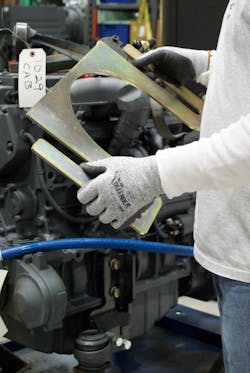Hands are the most used tools in the workplace, making their protection from on-the-job hazards critically important to maintaining employee productivity. Hand dangers are around every corner. Depending on the workplace, employees' hands are endangered daily from chemicals, abrasive surfaces, splinters, broken glass, and cuts or scrapes, among countless other hazards.
According to the US Department of Labor, injuries to hands accounted for nearly 25% of all lost-time industrial injuries - a total of 110,000 annually. Seventy percent of those injuries resulted when an employee was not wearing safety gloves, while the other 30 percent of hand injuries occurred while an employee was wearing the wrong kind of gloves.
Hand injuries are preventable. Safety gloves, correctly sized and engineered with the right materials, will defend workers from virtually any type of hazard. Unfortunately, employees often have a very limited understanding of how to select a glove properly based on the dangers they confront. The number of glove choices is vast,and the standards governing personal protective equipment, including hand protection-are not always easy to decipher.
Protective gloves, like any safety product, must be selected properly for the specific application. To do so, first determine the scope of the work, and next, identify any potential hazards within that scope that may injure employees' hands. If it is possible to eliminate the identified hazard by engineering or substitution, this is always the best means to protect the employee. If not, gloves should be used only as a last resort, along with other required PPE. Protective gloves tend to be less effective than other control measures but if avoiding contact is impractical or is not enough to protect employees then gloves are needed.
Recognize that an employee may be exposed to more than one hazard. For instance, the jobsite may contain corrosive chemicals or biological exposure, as well as sharp metals, or broken glass. If you are not sure of the hazard or hazards, confer with an ESH coordinator or industrial hygienist. Once gloves are selected, inform employees how to use them properly to protect themselves. Let them know when gloves should be replaced. If the gloves are reusable ask employees to rinse them before removal and tell them how they should be stored.
CHEMICAL PROOF GLOVES
A principle function of skin is to protect our bodies from exposure to potentially harmful components of the external environment. Skin does this remarkably well, but direct contact with chemicals poses a danger to the skin itself. Chemical reactions to skin can be a burn, dermatitis or chapping. Chemicals can also penetrate the skin and enter the bloodstream. Risk varies according to the chemical, its concentration, and time of contact among other safety factors. Refer to the product SDS for specifics. Section 8 of the SDS provides what types of PPE are necessary to protect the user. Section 11 has toxicological information such as potential local skin effects, as well as potential absorption through the skin and resultant acute and chronic effects.
Because different glove materials resist different chemicals, no one glove is suited for all chemical exposures. Dependant on the chemical, gloves can be fabricated with natural rubber, neoprene, nitrile rubber, butyl rubber, polyvinyl chloride, polyvinyl alcohol, Saranex™, Tychem®, Trellchem®. Key factors to review in selecting the material are breakthrough time, degradation and permeation rate. Refer to the glove manufacturer's test data for details.
OSHA 29 CFR 1910.138 (Hand Protection General Requirements) specifically addresses the need for hand protection or chemical protective gloves. This standard makes it mandatory to assess the job for chemical exposures, and then select the appropriate, chemical protective glove based on material, thickness, length and other traits. ANSI/ISEA 105-2016 is another source of information that provides a consistent, numeric-scale method for manufacturers to rate their gloves against certain contaminants and exposures.
CUT RESISTANT GLOVES
Tear, puncture, and cut resistant gloves are often constructed from materials such as high-grade stainless steel Kevlar®, and may feature a mesh aesthetic. Resistant to damage from sharp or abrasive objects such as glass and knives, these gloves are often ergonomically designed for a precise fit. Cut-resistant sleeves, often worn with cut-resistant gloves, extend protection from the wrist up towards the elbow or shoulder.
There are two major global standards used to evaluate the protection levels of work gloves: ANSI/ISEA 105 (U.S. Standard) and EN 388 (EU Standard). Besides Europe, EN 388 is also commonly cited in other parts of the world such as Canada, AUS/NZ and South America. In 2015-2016, significant changes were made to both to ensure consistency between different standards and to reduce the gaps between protection levels. The new ANSI/ISEA 105 scale, characterized by an 'A' in front of level numbers from A1 to A9, measures a glove's performance by the cutting force it can withstand in grams. For instance, an A1 glove can withstand from 200-499 grams of cutting force, while an A9 glove can withstand 6000+ grams of cutting force.
THERMAL PROOF GLOVES
Thermal proof gloves protect against extreme temperatures and are fabricated from a variety of materials, including:
- Neoprene: Neoprene gloves are used for protection against frost and burn injuries, as in the case of firefighting gloves. Besides its thermal resistant characteristics, this flexible and
- Aluminized Material: Aluminized material is capable of handling and withstanding extremely high temperatures (depending on the specific formula, up to and exceeding 2,000° F). Gloves made of this material are suitable for welding, furnace and foundry, and some laboratory applications.
When choosing the heat-resistant gloves for a task, you'll need to find out the precise temperature of the object, not just the ambient temperature. For example, an industrial oven might be 1000°F but the object being handled is only 600°F. Also, high temperature gloves are available as either gloves or mitts. Gloves are for applications that require dexterity, while mitts are for applications that require additional insulation for heat protection, added comfort, and longer wear. Heat-resistant gloves should be tested to ASTM F1060-87 (also know as C.H.A.R.) that establishes the maximum temperature at which a person can hold an object for more than four seconds before feeling pain, and for more than 15 seconds before getting a second-degree burn.
On the other end of the temperature spectrum, cold resistant gloves, commonly known as freezer gloves, protect employee hands from cuts and scrapes, while an inner insulation reduces the risk of frostbite. These gloves do not have the thickness or the high level of insulation associated with a ski type glove since that bulkiness would inhibit grip and dexterity when handling frozen foods. Polyethylene, glass fiber, polyester, and spandex are all used in the construction of cold storage thermal gloves. Water wicking on the glove's base layer moves moisture away from the skin, helping to keep hands dryer and warmer for a longer period of time.
GLOVES AND MACHINERY
Machinists who are operating rotating machines should not wear gloves. If machinists are working with a CNC machine, a lathe, a knee mill, or a drill press, wearing gloves near a rotating spindle can spell disaster. Machinery must have guards installed or incorporated into their design that prevent hands from contacting the point of operation or other moving parts.
GLOVE MAINTENANCE
Like any tool, gloves must be treated properly for them to perform their function. Protective gloves should be inspected before each use to ensure that they are not torn, punctured or made ineffective in any way. A visual inspection will help detect cuts or tears but a more thorough inspection by filling the gloves with water and tightly rolling the cuff towards the fingers will help reveal any pinhole leaks. Gloves that are discolored or stiff may also indicate deficiencies caused by excessive use or degradation from chemical exposure.
Wearing the right safety gloves is instrumental in preventing different workplace hand injuries, including cuts, punctures, burns, or abrasion injuries. It also saves costs incurred by the company each time a hand injury occurs, such as medical expenses that average $6,000 and lost-time compensation expenses that average $7,500. Hand injuries send more than one million workers to the emergency room each year. Your employees cannot afford to go barehanded or be wearing the wrong gloves, not when the cost of one preventable incident far exceeds the cost of an entire hand protection program.
Carrie Halle is vice president of marketing & business development for Rockford Systems, LLC.
About the Author
Carrie Halle
Vice President of Marketing & Business Development, Rockford Systems LLC
Carrie Halle is the Vice President of Marketing & Business Development for Rockford Systems, LLC.

